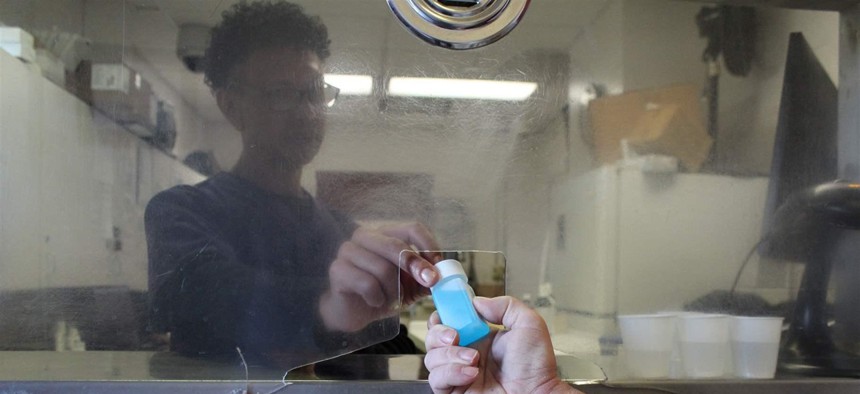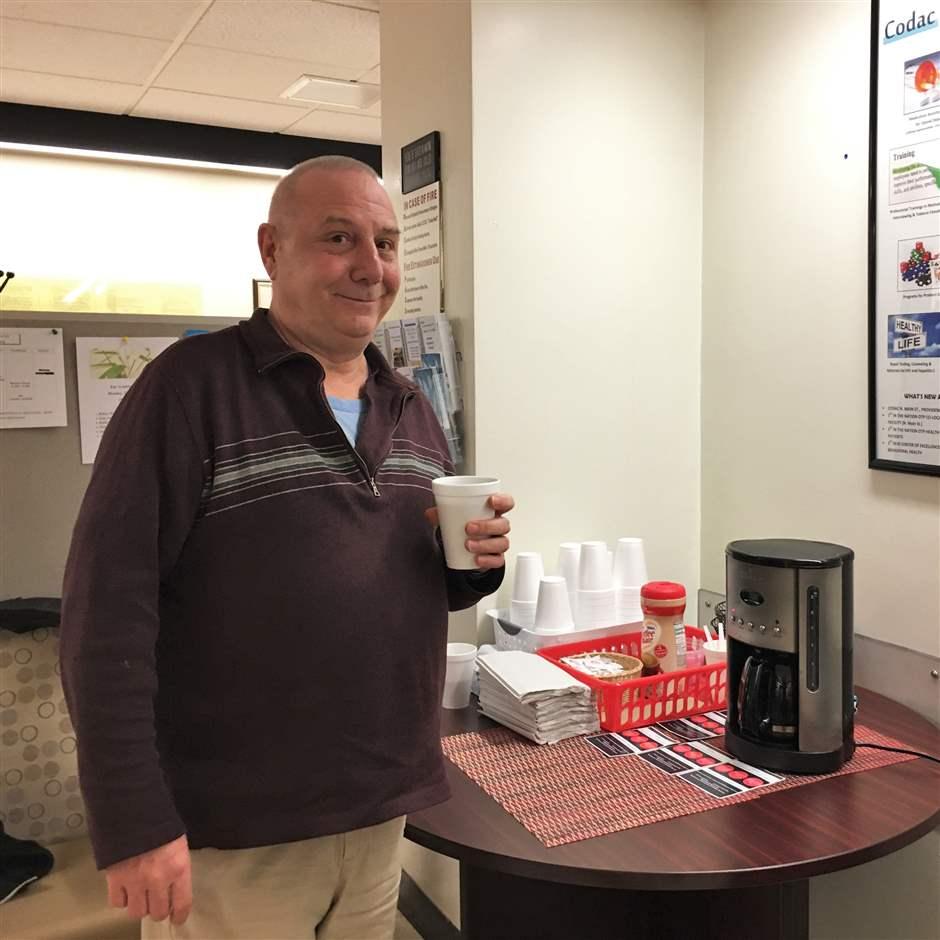This State Has Figured Out How to Treat Drug-Addicted Inmates

Nurse John Sepulveda demonstrates how he hands inmates their daily doses of methadone at a Rhode Island Department of Corrections prison in Cranston. Courtesy of the Rhode Island Department of Corrections
More jails and prisons are starting to offer medication-assisted treatment for inmates addicted to opioids. But it's available at just a very small fraction of correctional facilities across the country.
This story was originally published by Stateline, an initiative of the Pew Charitable Trusts.
CRANSTON, R.I. — On a gray, bone-chilling morning earlier this month, 18 men in a medium-security prison walked into an empty lunchroom and sat at stainless steel topped tables, placing both hands palms down, as if they were about to receive a manicure.
Over the next few minutes, they received the anti-addiction medication buprenorphine under their tongues, administered by a nurse and double-checked by guards—with military precision. Then they were strip-searched before returning to their cells.
This half-hour routine happens every day, part of a program developed at the Rhode Island Department of Corrections to ensure that the clear strips of buprenorphine the inmates need to maintain recovery and stay focused on rehabilitation aren’t diverted to black markets inside or outside the prison.
Nationwide, two-thirds of the country’s 2.3 million inmates are addicted to drugs or alcohol, according to the National Institute on Drug Abuse. But only a small fraction of those who need treatment behind bars receives it.
The vast majority of the nation’s nearly 2,000 state and federal prisons and 3,100 county and municipal jails do not offer addiction treatment that includes any of the three medications—methadone, buprenorphine and Vivitrol—approved by the U.S. Food and Drug Administration.
That’s changing, albeit slowly. An estimated 120 jails in 32 states and prison systems in 10 states now offer evidence-based treatment for opioid addiction, triple the number in 2018.
Rhode Island started providing medication-assisted treatment, or MAT, for opioid addiction in its unified prison and jail system in 2016.
And with the help of Democratic Gov. Gina Raimondo and a $2 million annual budget, it is doing more than any other state to ensure that all inmates who need addiction treatment have an opportunity to receive the best care available.
That means offering all inmates with an opioid addiction, whether they were previously in treatment or not, a choice of one of the three FDA-approved medications, plus counseling.
Research shows that MAT is at least twice as effective as abstinence-based treatment that does not include medications.
In most lockups, people who are using heroin, fentanyl or painkillers when they enter are forced into painful withdrawal.
The simple detox or “cold turkey” methods, even combined with motivational classes, fail 90% of the time, said Dr. Jody Rich, an addiction researcher at Brown University who studies Rhode Island’s correctional treatment program.
Tight Budgets
Even as more jails and prisons offer MAT, many limit the programs to people who received the medications before they were incarcerated. And few places offer a choice of all three drugs.
In many cases, that’s because state and local governments say they can’t afford it.
But advocates for prisoners argue that the failure to provide treatment to all inmates who need it also stems from a lack of concern for inmates’ welfare and a lack of understanding about the effectiveness of the medications.
Addiction physician R. Corey Waller of consulting firm Health Management Associates works with prisons and jails in several states. He says corrections officials often incorrectly believe that inmates who have detoxed after entering prison don’t need to take medications such as methadone or buprenorphine to control their cravings and prevent relapse, because they’re in a controlled environment with scant access to drugs.
“But prisons aren’t the sterile environment people think they are,” he said. “The pressures to use drugs inside are even greater than they are outside. On the outside, you can escape pressures, go to your aunt’s house or something. But when you’re in a jail or prison, if you try to ignore the inmate in your yard who wants to sell you drugs, you’re at risk for physical harm.”
Rhode Island’s MAT program is unique: It includes all three medications, which are offered not only to those on treatment medication when they enter, but also to inmates who enter prison as active users of heroin or other opioids to ease their withdrawal and get them into treatment.
The program also offers inmates who have detoxed during incarceration the opportunity to start any of the three medications before discharge, with appointments set up for continued treatment on the outside.
Research at Brown University shows that the state’s one-of-a-kind program has dramatically reduced overdose deaths after inmates are released. The number of recently incarcerated people who died from overdose dropped by two-thirds from 26 in the first half of 2016—before the program started—to just nine in the first half of 2017, after the program’s implementation.
And if you ask those who have graduated from the program, they’ll tell you it changed their lives.
“It’s a whole new world,” said Lloyd Baker, 58, comparing his life now with just a year ago when, he said, he spent every waking moment either using heroin or chasing it.
Baker left the Rhode Island Department of Corrections medium-security men’s prison in 2017 with a prescription for buprenorphine and an appointment with a treatment center. “It was all set up for me,” he said, “and it worked — for about a month and a half.”

But when a friend who had just received a cash windfall asked Baker to help him spend the money on heroin, Baker binged for more than a year, until overdosing twice in one day.
That’s when he decided to return to the kind of treatment he’d received during his 18-month stay at Cranston, he recalled. “They told me during treatment that relapse happens. But it’s not the end,” Baker said. “They said they’d take me back with open arms—and they did.”
These days, Baker attends a class three nights a week at an addiction recovery center here that he says feels like home. And he spends a lot of time walking his tiny white dog, Zippy, around his neighborhood.
“Half my friends are in graveyards,” he said, “because when they got out of prison, they used what they did before they got in—and now they’re gone. I was one of the lucky ones.”
Research shows that inmates with an opioid addiction who leave lockups without a medication to ease cravings and block the euphoric effects of opioids are at extremely high risk to die of an overdose within days of their release.
That’s because unless treated with medications, incarcerated people with addictions continue to crave drugs even though they have little access to them. At the same time, their tolerance drops, making it possible for a small dose of drugs to be lethal.
Twelve years ago, Baker served 17 months in a maximum-security prison in Florida that did not have a drug treatment program. He said he thought about drugs the whole time.
“You got out with blue jeans and a hundred dollars,” he said. “I no sooner got on the bus than I used the hundred dollars to buy drugs on the way home.”
A 2018 study in North Carolina found that, in the first two weeks after being released from prison, former inmates were 40 times more likely to die of an opioid overdose than someone in the general population.
Growing Momentum
In 2016, fewer than 40 prisons and jails offered methadone or buprenorphine for opioid addiction, both of which are narcotics and considered contraband by most corrections officials.
As of this month, at least 120 jails offer methadone, buprenorphine or both to some inmates while incarcerated, as well as Vivitrol if requested prior to re-entry, according to Stateline research.
In addition, 10 states—California, Connecticut, Delaware, Hawaii, New Jersey, Pennsylvania, Rhode Island, Vermont, Washington and West Virginia—are offering MAT in state-run prisons.
Separately, at least 300 jails and prisons that aren’t offering methadone or buprenorphine started providing one or two injections of Vivitrol prior to discharge—as a protection against overdose and potential gateway to recovery.
But research indicates that Vivitrol, approved by the FDA in 2010, may not be as effective as methadone (approved in 1972) or buprenorphine (approved in 2002) in treating addiction in incarcerated people.
The recent growth in MAT programs results in part from federal lawsuits in multiple states brought by the American Civil Liberties Union to require prisons and jails to provide addiction medications under the Americans With Disabilities Act and as part of inmates’ constitutional rights to adequate health care.
The expansion also is an attempt to manage the incoming flood of heroin- and painkiller-addicted inmates over the past decade as the opioid epidemic ensnared millions of Americans, many of whom resorted to crimes to pay for their habits.
Both the National Sheriffs’ Association and the National Commission on Correctional Health Care support the use of MAT in corrections and offer guidelines on how to implement an effective program.
Fear of Theft
But some sheriffs and top prison officials continue to resist the introduction of methadone and buprenorphine into their facilities, because they fear the narcotics could be diverted and contribute to an already troublesome illegal drug trade within correctional facilities.
Cranston officials go to great lengths to prevent that.
But not all prisons and jails are willing to go through that kind of process, and some officials say they can’t afford the staff time it takes and don’t have enough space in their facilities to administer the daily drugs.
That’s despite evidence that providing the medications in correctional facilities improves conditions inside and reduces crime and recidivism once inmates are released.
According to the National Institute on Drug Abuse, “decades of science shows that providing comprehensive substance use treatment to criminal offenders while incarcerated works, reducing both drug use and crime after an inmate returns to the community.”
Rhode Island Department of Corrections Director Patricia Coyne-Fague, who became acting director of the system in January 2018, two years after the state had launched its addiction treatment program, said it took some time before she understood the value of MAT.
“At first, I didn’t understand it. It didn’t make sense to me. We’re trying to keep drugs out of corrections, why would we bring them in? Why would you start someone on methadone and buprenorphine when they’ve been clean for 10 years?”
Then, she said, she began to see that inmates had been abstinent all those years, but not in recovery. “When I saw the numbers of people not dying after release, that’s all I had to see,” she said.
According to Rich, “Corrections officials around the country are starting to realize that MAT is not only good for the health of inmates, but it’s good for the health of the institutions.”
“Inmates with untreated addiction struggle to get drugs inside, resulting in violence, extortion, stress, conflict and a strengthening of illegal drug networks and gangs.
“Once you put them on addiction meds, most inmates become fine, perfectly reasonable people and stop causing trouble. It begs the question of why we lock them up for the disease of addiction in the first place.”





